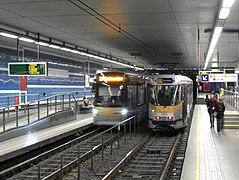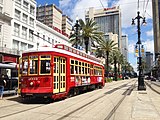Premetro




Premetro (sometimes pre-metro) is a type of light rail transit. Here infrastructure is gradually built with the goal to use rapid transit trains in the distant future, but using trams or light rail vehicles preliminary in the meantime. This infrastructure consists of tunnels and/or viaducts, so vehicles have no conflicts with other traffic. To achieve that these rapid trains will be able to use the infrastructure, wider curves and lesser grades need to be designed and built.[1][2][3][4][5]
Premetro versus semi-metro
The use of tram vehicles in tunnels originated in the United States in the nineteenth century and was often called "subway–surface line". Later, in the second half of the twentieth century the term "semi-metro" was coined for tram systems with some sections in tunnels and on viaducts. Only when a semi-metro section is designed for later use of heavy rapid transit trains, it falls in the premetro category. The large scale report "Light Rail Transit: A State of the Art Review" describes on page 9 the relationship of premetro systems to broader terms as follows:
Certain design features distinguish these systems from semi-metro or conventional light rail transit systems[2]
The same distinction is made in glossaries.[1][6] During the period when tram vehicles are used, the specific line falls into the light rail category.[7][8]
History
An early example was the Tremont Street subway (1897) in Boston, today part of the MBTA Green Line. This tunnel was intended solely to reduce streetcar congestion on surface streets, not for later conversion to metro service.[9] However between 1901 and 1908, two out of four tracks were used for rapid transit service including high platforms.[10] Several early streetcar tunnels, including the Steinway Tunnel and East Boston Tunnel, were later converted to metro operation. However, the small loading gauge, tight curves, and steep grades of the streetcar tunnels required shorter metro cars than otherwise desirable.[9] In 1950 Stockholm effectively used a pre-war tramtunnel for its first rapid transit line.[11]
Second generation
The modern premetro concept Stadtbahn began in 1960s Germany, as rising traffic congestion due to auto ownership led to the construction of new transit systems. Rather than building costly metro lines immediately, some cities built only the downtown tunnels. They could be used by existing tram lines in the short term, with the intention of full metro conversion later - hence "pre-metro".[12] The idea spread to other European countries in the 1970s, especially Belgium, where such systems were explicitly named premetros.[12] Also one segment of Vienna's U2 metro line (Rathaus-Museumsquartier) is an in 1980 converted underground tramway line, which was constructed in 1966.
Examples
Previously converted lines
- Line 2 (Rio de Janeiro) in Brazil[13]
- Two stations of the line Roma – Fiuggi – Frosinone were converted to metro standards to become part of the Rome Line C.
- Vienna Pre-metro in Austria
Lines being converted
Lines without plans to be converted
See also
References
- ^ a b Program, Transit Cooperative Research (2013). "11 Glossary and symbols". Transit Capacity and Quality of Service Manual. Transportation Research Board. p. 53. ISBN 978-0-309-28344-1.
pre-metro — a light rail transit system designed with provisions for easy conversion to heavy rail (rail rapid transit).
- ^ a b De Leuw, Cather & Company (1976). Light Rail Transit: A State of the Art Review, Executive Summary. p. 47. Retrieved 30 August 2023.
This step-by-step planning approach to building rail rapid transit is known as pre-metro, implying the intention to ultimately construct a fully grade separated route to be used by rail rapid transit or metro trains.
- ^ Jenkin, P. (1988). Urban Railways and the Civil Engineer. Thomas Telford. ISBN 978-0-7277-1337-7. Retrieved 9 August 2024.
Pre-Metro is an extreme case of light rail, on segregated right of way, and designed to upgrading to metro when passenger demand increases sufficiently.
- ^ Mattila, Matti (5 August 2012). Wizzit Magazine 3/2011. Annorlunda Mediatuotanto Oy. p. 19. ISBN 978-1-4478-2842-6. Retrieved 9 August 2024.
Premetros also allow a gradual upgrade of existing tramways to rapid transit, thus spreading the investments costs over time.
- ^ John Hoyle (16 May 1975). "Letters to the editor -- The tram is the answer". Sydney Morning Herald. Retrieved 13 January 2014.
Cities such as Frankfurt and Cologne in West Germany have further developed their tramway system by introducing a concept known as "premetro." In this system trams or light rail vehicles make extensive use of tunnels, reserve track and by utilizing folding steps these vehicles can operate through high or low stopping places.
- ^ "PREMETRO [1 record]" (in French). TERMIUM Plus®. 8 October 2009. Retrieved 23 July 2024.
Un semi-métro peut constituer une étape intermédiaire vers la constitution d'un véritable métro lorsqu'il est envisagé d'étendre par phases successives le site propre intégral à la totalité de la ligne ou du réseau. Les ouvrages sont alors dimensionnés au gabarit du futur métro et on parle du pré-métro.
- ^ Transportation Research Board National Research Council (1989). Urban Public Transportation Glossary. Retrieved 16 February 2023.
pre-metro: a light rail transit system designed with provisions for easy conversion to rail rapid transit
- ^ Vuchic, Vukan R. (2007). Urban transit systems and technology. Hoboken, N.J: J. Wiley & Sons. p. 580. doi:10.1002/9780470168066.fmatter. ISBN 9780471758235. Retrieved 7 October 2023.
PREMETRO—An LRT system designed with provisions for easy conversion into RRT (metro).
- ^ a b Cudahy, Brian J. (1972). Change at Park Street Under. Stephen Greene Press. pp. 10-11, 31-33. ISBN 0828901732. LCCN 72081531.
- ^ "Boston Elevated Railway Company, Main Line Elevated Structure (HAER)". www.nycsubway.org. Retrieved 7 August 2024.
the outer tracks of the Tremont Street Tunnel which was adapted to elevated train use in 1901 by the construction of higher platforms
- ^ Geoffrey, Skelsey (2018). Brussels Metro to Grow As Pre-metro Shrinks. London Underground Railway Society. p. 3.
- ^ a b Ian Yearsley (21 December 1972). "Trams are coming back". New Scientist. Reed Business Information Ltd. Retrieved 14 January 2014.
But instead of building the entire expensive systems immediately, the Germans hit on the idea of building only the city centre tunnels at first. Intended in the long run to be extended to full undergrounds, in the short term they could be used by trams which would continue to run on the surface outside city centres. The idea spread to other European countries, especially Belgium, where it became known as pre-metro. Today Brussels, Frankfurt, Stuttgart and many other cities are filling their central business districts with construction sites to move the trains underground.
- ^ Araujo, Ricardo Melo (December 2017). Plano conceitual de transporte de passageiros sobre trilhos na Região Metropolitana de Curitiba (in Portuguese). Curitiba. p. 36. Retrieved 30 October 2024.
{{cite book}}: CS1 maint: location missing publisher (link) - ^ Geoffroy Fabre (19 March 2014). "Une station fantôme au secours du futur Métro Nord de la STIB". RTBF. Retrieved 9 May 2014.
- ^ "Antwerpen Tram & Premetro". UrbanRail.net. 2013. Retrieved 22 January 2014.
Antwerpen rail network is a typical premetro network.

